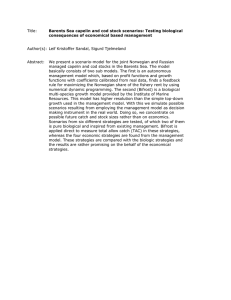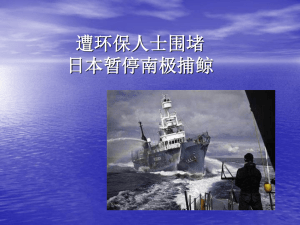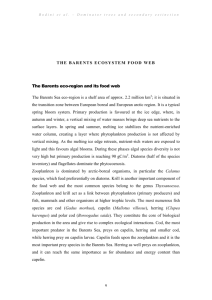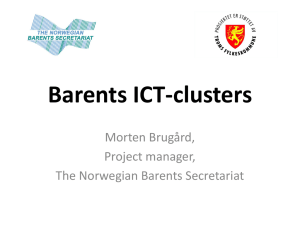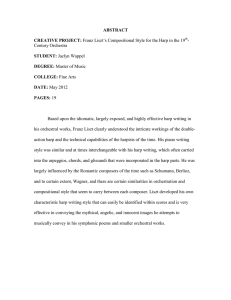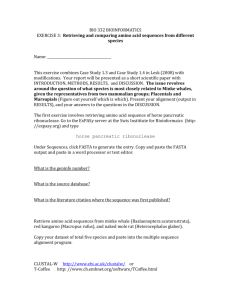Top Predators in Marine Ecosystems. Their Role in Monitoring and... Cambridge, UK.: Cambridge University Press 2006. ISBN 978-0-521-84773-5. s. 310-323
advertisement
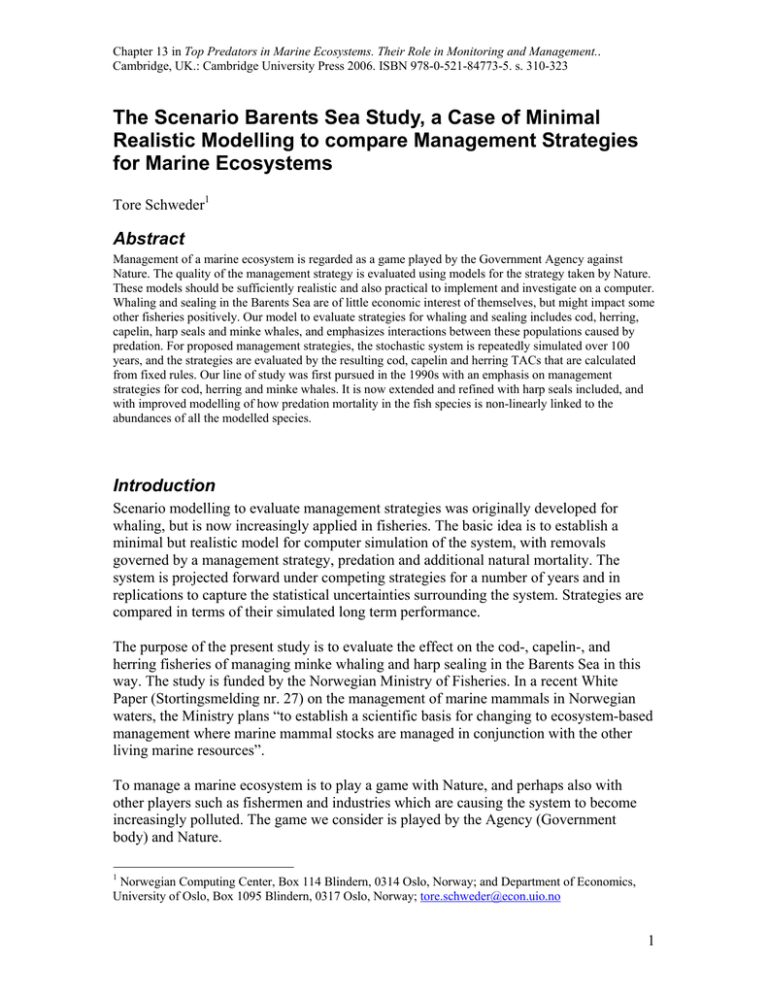
Chapter 13 in Top Predators in Marine Ecosystems. Their Role in Monitoring and Management.. Cambridge, UK.: Cambridge University Press 2006. ISBN 978-0-521-84773-5. s. 310-323 The Scenario Barents Sea Study, a Case of Minimal Realistic Modelling to compare Management Strategies for Marine Ecosystems Tore Schweder1 Abstract Management of a marine ecosystem is regarded as a game played by the Government Agency against Nature. The quality of the management strategy is evaluated using models for the strategy taken by Nature. These models should be sufficiently realistic and also practical to implement and investigate on a computer. Whaling and sealing in the Barents Sea are of little economic interest of themselves, but might impact some other fisheries positively. Our model to evaluate strategies for whaling and sealing includes cod, herring, capelin, harp seals and minke whales, and emphasizes interactions between these populations caused by predation. For proposed management strategies, the stochastic system is repeatedly simulated over 100 years, and the strategies are evaluated by the resulting cod, capelin and herring TACs that are calculated from fixed rules. Our line of study was first pursued in the 1990s with an emphasis on management strategies for cod, herring and minke whales. It is now extended and refined with harp seals included, and with improved modelling of how predation mortality in the fish species is non-linearly linked to the abundances of all the modelled species. Introduction Scenario modelling to evaluate management strategies was originally developed for whaling, but is now increasingly applied in fisheries. The basic idea is to establish a minimal but realistic model for computer simulation of the system, with removals governed by a management strategy, predation and additional natural mortality. The system is projected forward under competing strategies for a number of years and in replications to capture the statistical uncertainties surrounding the system. Strategies are compared in terms of their simulated long term performance. The purpose of the present study is to evaluate the effect on the cod-, capelin-, and herring fisheries of managing minke whaling and harp sealing in the Barents Sea in this way. The study is funded by the Norwegian Ministry of Fisheries. In a recent White Paper (Stortingsmelding nr. 27) on the management of marine mammals in Norwegian waters, the Ministry plans “to establish a scientific basis for changing to ecosystem-based management where marine mammal stocks are managed in conjunction with the other living marine resources”. To manage a marine ecosystem is to play a game with Nature, and perhaps also with other players such as fishermen and industries which are causing the system to become increasingly polluted. The game we consider is played by the Agency (Government body) and Nature. 1 Norwegian Computing Center, Box 114 Blindern, 0314 Oslo, Norway; and Department of Economics, University of Oslo, Box 1095 Blindern, 0317 Oslo, Norway; tore.schweder@econ.uio.no 1 Chapter 13 in Top Predators in Marine Ecosystems. Their Role in Monitoring and Management.. Cambridge, UK.: Cambridge University Press 2006. ISBN 978-0-521-84773-5. s. 310-323 The concept of strategy is central to game theory. A management strategy is a feed-back rule that specifies the action to be taken, given the history of the process as observed by the player. For our purpose, the actions open to the Agency are to set total allowable catches (TACs) for removals of harp seals and minke whales. The Agency also sets TACs for the fisheries. TACs are assumed to be exactly filled if abundance allows. Fishermen behave also according to economic realities, and may discard or take more than the TAC. These economic realities are disregarded here. The strategy of Nature is determined by the internal dynamics of the ecosystem, and its dynamic reaction to the removals caused by the fisheries. The better the Agency knows Nature’s strategy, the better it can assess the quality of a given management strategy for whaling and sealing. Our study is an attempt to assemble the available knowledge and data pertinent to the relevant dynamics of the upper trophic level of the ecosystem. Despite more than 100 years of marine research in the area and despite the system is less complex than many other ecosystems and comparably well known, our knowledge of the Barents Sea ecosystem is rather limited. The quality of understanding varies considerably depending on the topic. For features of the ecosystem about which little is known, the model must be simple in order not to spread the available information too thinly. Other better known features might be less relevant for the interaction between the modelled species, and are therefore modelled in less detail than is possible. Our aim is not a detailed description of the ecosystem representing all available knowledge, but rather a practical and reasonably realistic model tailored to the purpose of the study. Borrowing a term from Punt and Butterworth (1995), a model that balances realism and uncertainty, and that is operational and practical to use, is called a minimal realistic model. We consider the Barents Sea, including the spawning grounds for North East Arctic cod in Lofoten, and also a residual area where Norwegian spring spawning herring and minke whales are found when they are not present in the Barents Sea. Only young herring migrates to the Barents Sea. The minke whales feed in the study area and breed elsewhere during winter. With our limited and pragmatic purpose, we will include only harp seals, minke whales, cod, capelin and herring in the model. Hamre (1994) describes the main features of the Barents Sea- Norwegian Sea ecosystem. A strategy should be evaluated in terms of its anticipated performance in the long run. The system needs more than 100 years to become stationary, due the slow dynamics of minke whales. We will therefore simulate catches and stock status over at least a hundred-year period, and study performance by statistics summarising the simulation results. It is beyond the scope of this study to give weights to the various objectives for management, and to interpret results in financial terms. The model has yearly stochastic variation, mainly in fish recruitment and in the stock abundance estimates on the basis of which TACs are set. This last uncertainty applies also to abundance estimates for minke whales and harp seals, and translates into stochastic variation in TACs for these species as well. 2 Chapter 13 in Top Predators in Marine Ecosystems. Their Role in Monitoring and Management.. Cambridge, UK.: Cambridge University Press 2006. ISBN 978-0-521-84773-5. s. 310-323 The Agency is faced with uncertainties with respect to the population dynamics of the key stocks, and also to the interactions caused by predation between stocks. These uncertainties are handled by drawing parameters from statistical distributions for each run of the simulation model, but uncertainties with respect to functional forms are not addressed. Historical background The present study (2002-2004) is a sequel to a previous Scenario Barents Sea study. The aim of that earlier study was to compare management strategies for cod, capelin and herring (Hagen, Hatlebakk and Schweder 1998). The model was previously extended to study the effects on the fisheries of retuning the Revised Management Procedure of the International Whaling Commission (the RMP of the IWC, International Whaling Commission 1994) for minke whales (Schweder, Hagen and Hatlebakk 1998; 2000). In addition to including harp seals in the current model, the structural forms of the predation models are changed, and they are re-estimated. Our study, and that of Punt and Butterworth (1995), which was developed to reflect recommendations reported in Butterworth and Harwood (1991), has been inspired by the simulation approach taken when the RMP of the IWC was developed for managing single baleen whale stocks (Kirkwood, Hammond and Donovan, 1997). The resulting RMP is robust against the type and extent of uncertainties that usually surrounds stocks of baleen whales, as demonstrated in a scenario study focusing on uncertainties represented by variability and bias in survey data, and in variations in the population dynamics, e.g. in the shape and strength of density dependent recruitment, changes in carrying capacity, episodic events etc. In the early 1970s the Club of Rome based its gloomy predictions on scenarios simulated on computers to illustrate environmental effects of population growth and industrial activity. This work was inspired by Buckminster Fuller, who educated many Americans in strategic thinking and in the use of simulation through computers and otherwise to improve environmental and other policies. He conducted military war games to save Spaceship Earth from destruction (http://www.bfi.org) throughout American university campuses, and was an inspiration to the environmental movement. The present Scenario Barents Sea model Overview Cod, capelin, herring, harp seals and minke whales are distributed over the seven areas used in previous studies (Bogstad et al. 1997) plus a residual area (Figure 1), and over age and month. Fish are also distributed over lengths. The chosen subdivision of the study area and the time step is regarded as the coarsest possible temporal and spatial stratification respecting gradients in seasonal overlaps between predators and prey in the Barents Sea system (S. Tjelmeland, personal communication, 2004). 3 Chapter 13 in Top Predators in Marine Ecosystems. Their Role in Monitoring and Management.. Cambridge, UK.: Cambridge University Press 2006. ISBN 978-0-521-84773-5. s. 310-323 Moving from one month to the next, surviving fish of the same length are allocated to new length groups according to an individual growth schedule which depends on season and species. Individual growth in cod depends on the supply of capelin, but is independent of prey availability for capelin and herring. A fixed length-weight relationship for each fish species is used for calculating the biomass of the species at any time. This is needed because fish TACs and predation are calculated in biomass terms. The population dynamics model for minke whale is taken from International Whaling Commission (1993), and is identical to that in Schweder et al. (1998). The model for harp seal is taken from Skaug and Øien (2003). Recruitment in cod, capelin and herring is modelled by Beverton-Holt functions augmented with stochastic variability. Minke whales and harp seals are top predators. Their population dynamics is modelled as unaffected by fish stock abundance. While this is not quite realistic, it is nevertheless considered adequate for present purposes because the modelled population dynamics broadly reflect prey abundances similar to those expected over the simulation period. The marine mammals prey on all three species of fish, and also on other organisms, as do cod which is a cannibal. Herring prey on capelin larvae. Capelin is at the base of the model. The interactions between populations are modelled solely as mortality due to predation. These interactions are additive in the sense that they act only to cause removals. Hjermann, Stenseth and Ottersen (2004) found the mortality factors to be additive and not compensatory for Barents Sea capelin. Fishing is also assumed to cause removals but not have indirect effects. In addition to mortality due to modelled removals, there is a component of fixed residual natural mortality. Predation is modelled in two steps. The daily biomass consumed is calculated for each group of predators from energetic considerations and from other sources,. This consumption is then split between the groups of prey according to prey choice probabilities. The prey choice probabilities are estimated from stomach content data and estimated prey availability by time and area. Key equations of the model are discussed below, together with some comments on the estimation of their parameters. Additional information is found at: http://www.nr.no/files/samba/emr/scenario_document.pdf Recruitment and yearly dynamics Juvenile capelin are recruited as one year olds on 1 October. Juvenile cod and herring are recruited as one year olds on 1 January. Given a spawning stock with biomass B , the number of recruits, R , one year later is calculated from the Beverton-Holt function R = Lµ B /( B + η ) , 4 Chapter 13 in Top Predators in Marine Ecosystems. Their Role in Monitoring and Management.. Cambridge, UK.: Cambridge University Press 2006. ISBN 978-0-521-84773-5. s. 310-323 with multiplicative log-normal stochastic variation L with median 1 and coefficient of variation σ , maximal recruitment in median years µ , and half-value parameterη . There are stochastically chosen abnormal years, where the recruitment parameters are switched to more productive values. Newly recruited fish are distributed by length group. Recruitment in minke whales follows the age- and sex-structured model used by the International Whaling Commission. The median age at maturity is seven years, and the fecundity drops as the number of mature females N approaches a carrying capacity K according to the Pella Tomlinson formula ( ( R = N β 1+ α 1− ( N / K ) z )) , where β is the mean number of live births per year for mature females at carrying capacity, α is the resilience parameter, and z is the degree of compensation. The last two parameters determine the stock level, here 60% of carrying capacity, corresponding to maximum sustainable yield. Recruitment to the exploitable stock happens one year after birth. The recruitment parameters are estimated using catch data, abundance data, and a series of relative abundance indices based on catch and effort data (Schweder et al. 1998). Recruitment in harp seals is also modelled by the Pella Tomlinson formula above, but with z = 1 degree of compensation, making the maximum sustainable yield stock level around 50% (Skaug and Øien, 2003). Migration and monthly dynamics Monthly age-dependent transition matrices between areas (migration matrices) based on survey data were developed by Bogstad et al. (1997). The stationary distributions related to these matrices are used to distribute the various populations over areas, by month and age. Mortality in fish has three components: removals due to fishing, removals due to modelled predation, and residual natural mortality. Removals due to fishing are calculated from the yearly TAC, and distributed according to a specified scheme over areas and months. TACs for cod and herring are calculated from yearly abundance estimates obtained from a simple VPA assessment by applying fixed fishing mortalities, and based on catch data and yearly survey data simulated with noise. Capelin is managed according to the approach described in Gjøsæter, Bogstad and Tjelmeland (2002) which, approximately, is to set aside the estimated amount of capelin needed to feed the cod, and also 500 thousand tons of capelin to spawn. The removals due to predation in a given month and area are calculated from the number of predators present and the biomass of all their prey species, as described below. From the number of individuals in a given category at the beginning of a month, the number 5 Chapter 13 in Top Predators in Marine Ecosystems. Their Role in Monitoring and Management.. Cambridge, UK.: Cambridge University Press 2006. ISBN 978-0-521-84773-5. s. 310-323 consumed by predators and the number harvested are subtracted, and the remainder are reduced further as a result of the residual mortality rate. Predation Predation models are estimated anew for cod, minke whales and harp seals. They consist of two components: total amount eaten per day, and diet choice probabilities depending on prey abundance. The quantity consumed is estimated from energetic considerations for harp seals and minke whales, and also from experimental and observational studies for cod. The choice probability models have a common multiple logistic format, and are estimated by comparing the type of prey found in sampled stomachs to estimated prey abundance at the time and in the area of sampling. Food takes time to digest, and sampled stomachs often have mixed contents. Each stomach is therefore regarded as representing three feeding events, and a rule codes them by food item. Minke whales, for example, can choose between capelin, herring, cod and other food, indexed from 1 to 4. If only one item is found in a stomach, all three feeding events are coded by this item. For a covariate vector x representing area-specific abundance of cod, capelin and herring, and for parameter vectors β k related to food item k , the model consists of the linear predictors θ k = ∑ β ki xi leading to the logistic choice i probabilities pk = exp (θ k ) / ∑ exp (θ j ) . 4 j =1 Zhu (2003) estimated the following diet choice model for minke whales θ k = −1.82 I herring − 2.52 I capelin − 3.63I cod + 0.000231Bk + 0.265log( Bk ) , where Bk is abundance (in thousands of tons) of fish species k in the area, and I herring indicates whether herring is present or not, and similarly for cod and capelin. Other food is the reference category, θ other = 0 (i.e. pother = 1/ (1 + θ cod + θ cap + θ her ) ). All coefficients, except that for linear abundance, are highly significant. For harp seals, stomachs are sampled mainly on the ice north in the Barents Sea in summer (Nilssen et al. 2000). Folkow, Nordøy and Blix (2004) found from satellite tagging that Greenland Sea harp seals regularly migrate to the Barents Sea in summer and autumn, and spend about half their time there in open water, presumably feeding on capelin. The stomach contents found in sampled harp seals are therefore not representative of the diet in the important summer feeding period in the Barents Sea. The same presumably applies to harp seals from the White Sea, which constitutes the dominant harp seal stock in the Barents Sea. 6 Chapter 13 in Top Predators in Marine Ecosystems. Their Role in Monitoring and Management.. Cambridge, UK.: Cambridge University Press 2006. ISBN 978-0-521-84773-5. s. 310-323 Management Fisheries are modelled to be managed by fixed and simple rules. Minke whaling is managed by the RMP of the IWC, tuned at three different levels, while harp sealing is managed by three different rules taken from ICES (2001). There are thus nine different combinations of management procedures for whaling and sealing to compare. Discussion Current management Fish TACs for cod are set to target a fishing mortality of F = 0.4 when spawning stock biomass is estimated above B pa . The stock is assessed by the VPA-method XSA, see ICES (2004). The capelin and herring fisheries are essentially managed as modelled. Minke whaling Currently, Norway has a fleet of some 33 fishing vessels that harvest minke whales in the summer months in Norwegian waters. Whaling accounts for about 25% of the income for this fleet, and is economically sustainable. Minke whaling resumed in 1993 after it was stopped in 1987. The catch has increased from some 250 whales in 1993-1995 to some 600 whales in recent years. This is slightly below the TAC calculated from the management strategy. Vessel quotas are given to licensed whalers. The catch is closely controlled with skilled observers on board. The TAC for minke whales is calculated by the RMP of the IWC. The input data to the RMP is the catch series and the series of absolute abundance estimates obtained from double platform line transect surveys (Skaug et al. 2004). The RMP can be tuned to target various population levels under cautious standard assumptions. In the early years, a target level of 72% of carrying capacity was used to set Norwegian minke whale TACs. This target level is that which would be reached after 100 years of application of the RMP to a stock, originally at its pristine level, with the lowest productivity rate considered plausible. In 2003 the tuning level was reduced to 66%, and for 2004 to 62%, resulting in higher TACs. Harp sealing Norwegian sealing is currently a small heavily subsidized industry carried out with old specialized sealing vessels. In the 1990s the yearly average number of harp seals taken in the Barents Sea by Norway was 6200, and has declined in recent years. Norway manages harp sealing in the Barents Sea together with Russia, and according to advice from ICES, which calculates TACs to keep the stock at its current level. The White Sea – Barents Sea stock is now estimated to comprise nearly two million adults, and the TAC was 53000 adult equivalents (one adult equals 2.5 pups) in 2001-2003, well above the catch. Pups become adult at age 1. 7 Chapter 13 in Top Predators in Marine Ecosystems. Their Role in Monitoring and Management.. Cambridge, UK.: Cambridge University Press 2006. ISBN 978-0-521-84773-5. s. 310-323 The economics of sealing has improved somewhat recently, but sealing will probably need substantial subsidies to raise the catch to what is currently regarded as sound from an economic perspective for the fishery as a whole (Stortingsmelding nr. 27). Management issues The Norwegian Government wants to develop a management strategy for sealing and whaling as part of a management regime for the ecosystem containing fish and marine mammals. For this to have scientific support, substantial research is needed, as acknowledged in the White Paper. Since harp seals, cod and capelin are managed jointly by Norway and Russia, while herring is managed by five parties: Norway, Russia, the Faroes, Iceland and the EU, management of this ecosystem is far from being a national issue for Norway alone. The model described above is an improvement of the model used by Schweder et al. (1998), who studied the effect on the fisheries of re-tuning the RMP of the IWC for minke whaling. The revision is not yet complete, and no results are available. To illustrate the type of results anticipated, our earlier tentative conclusion was that on retuning the RMP from targeting 72% of carrying capacity down to 60%, annual catches increase by some 300 minke whales, and 0.1 million ton cod on average. The effect on the herring fishery was unclear. The effect on the long term minke whale abundance was a reduction from about 96000 to 87000 whales. Whether the previously estimated effects on fisheries from increased minke whaling will be maintained in our current study remains to be seen. It also remains to be seen whether increased sealing will influence the fisheries positively to the degree currently expected by the Government and fishermen. Modelling considerations The various parts of the model were first estimated on relevant data, but in isolation from the rest of the model and from other data. The model as a whole is however more than the sum of its parts, and this piecewise estimation has turned out to be unsatisfactory. To balance the model it has been necessary fit the model simultaneously to historical data. This is work in progress. The approach is the following. Assume abundance estimates with associated uncertainty measures to be available for years 1,",T . From estimated stock status in year t , the model predicts the stock status in year t + 1 when all parameters have given values. Comparing the abundance estimates and the one-year predicted stock status in year t + 1 , accounting for observed catches, leads to a likelihood component. In addition to these likelihood components, each piecewise fitting results in a likelihood component. The total likelihood is then obtained by combining all the likelihood components, and parameters are estimated by maximizing this combined likelihood. 8 Chapter 13 in Top Predators in Marine Ecosystems. Their Role in Monitoring and Management.. Cambridge, UK.: Cambridge University Press 2006. ISBN 978-0-521-84773-5. s. 310-323 The log-likelihood function is expected to be approximately quadratic in the parameter vector, perhaps after a parametric transformation. The (transformed) parameter vector then has a multivariate normal confidence distribution representing the uncertainty in estimated model parameters (Schweder and Hjort, 2002). Conclusion Our model rests on a number of assumptions of varying degrees of realism. Feedback from fish to marine mammals is disregarded. Little is actually known of this feedback, which presumably is of importance at least for harp seals (Haug and Nilssen, 1995). The modelled populations interact only by removals due to predation. Other interactions are indeed conceivable. The residual mortality rate is assumed constant, but is presumably variable. The category “other food” has been modelled as always available in sufficient supply. There are also a number of assumptions regarding structure and data that are open to criticism. The predation model for harp seals is, for example, based on selective and weak data. Making the model more realistic will on most counts entail more complexity. The uncertainties surrounding the model are indeed substantial. They are handled by drawing parameter values from statistical distributions in each simulation run. These distributions will also rest on assumptions, and will broadly represent sampling variability in the data used to estimate coefficients. There are additional uncertainties not taken into account, particularly regarding the structure of the model and functional forms. To establish a minimal realistic model for the upper trophic levels of the ecosystem in the Barents Sea, also as regards the handling of uncertainty, is quite a challenge to address adequately. The alternative to scenario modelling is however not to model, and thus to leave the choice of management strategy to qualitative judgment. This will probably lead to a bad strategy, perhaps based on political compromises without much consideration for ecosystem dynamics. From this point of view, our model might in fact be criticized for being too complex relative to the available knowledge and data, and relative to the purpose of the exercise. Our model, programmed in 25000 lines of C-code, might actually be too complex. Having struggled to estimate recruitment- and mortality parameters by fitting the model to historical data, we have not yet managed to balance the model to our satisfaction. When simulating the model, stock trajectories in some of the runs are implausible, and they vary too much between runs compared to historical data. Our small project is thus unsuccessful in that no comparative simulation experiments useful for management could be performed. As mentioned, the Norwegian Government wants to move towards ecosystem management of marine mammals based on science. This commitment to science is encouraging. Our project might have been useful as a learning exercise, but more research is needed to establish a sufficiently credible model needed for ecosystem management. In addition to the research needs created by the Norwegian commitment to ecosystem management, we think this research aiming at a scenario model for the Barents 9 Chapter 13 in Top Predators in Marine Ecosystems. Their Role in Monitoring and Management.. Cambridge, UK.: Cambridge University Press 2006. ISBN 978-0-521-84773-5. s. 310-323 Sea should be carried forward also for general reasons. The Barents Sea system is in fact less complex than other marine systems of comparable size in terms of biomass in the the upper trophic level, and if marine ecosystem management at all is possible, it should indeed be so in the Barents Sea Acknowledgements Thanks to Gro Hagen of Norwegian Computing Center for keeping the computer program under control, and to Bjarte Bogstad, Ulf Lindström and Sigurd Tjelmeland of the Marine Institute, for providing data and biological insight. References Bogstad, B., Hiis Hauge, K. and Ulltang, Ø. 1997. MULTSPEC – A Multispecies Model for Fish and Marine Mammals in the Barents Sea. J. Northw. Atl. Fish. Sci. 22: 317-341. Butterworth, D.S. and Harwood, J. 1991. Report on the Benguela Ecology Programme Workshop on Seal-Fishery Biological Interactions. Report on the Benguela Ecology Programme, South Africa, 22 Folkow, L.P., Nordøy, E.S. and Blix, A.S. 2004. Distribution and diving behaviour of harp seals (Pagophilus Groenlandicus) from the Greenland Sea stock. Unpublished paper. Gjøsæter, H., Bogstad, B. and Tjelmeland, S. Assessment methodology for Barents Sea capelin, Mallotus villosus (Müller), ICES J. Mar. Sci. 59: 1086-1095 Hagen, G.S., Hatlebakk, E. and Schweder, T. 1998. Scenario Barents Sea. A tool for evaluating fisheries management regimes. In Models for multi-species management. (Tor Rødseth, ed.). Physica-Verlag, pp 173-226. Hamre, J. 1994. Biodiversity and exploitation of the main fish stocks in the Norwegian Sea- Barents Sea ecosystem. Biodiversity and Conservation 3: 473-292. Hjermann, D.Ø., Ottersen, G. and Stenseth, N.C. 2004. Competition among fishermen and fish causes the collapse of Barents Sea capelin. Proceedings of the National Academy of Sciences 101: 11679-11684. ICES 2001. Report of the Joint ICES/NAFO working group on harp and hooded seals. ICES CM 2001/ACFM:08. ICES 2004. Report of the Arctic Fisheries Working Group, ICES C.M. 2004/ACFM:28. International Whaling Commission, 1993. Specification of the North Atlantic minke whaling trials. Rep. int. Whal. Commn 43: 189-196. 10 Chapter 13 in Top Predators in Marine Ecosystems. Their Role in Monitoring and Management.. Cambridge, UK.: Cambridge University Press 2006. ISBN 978-0-521-84773-5. s. 310-323 International Whaling Commission, 1994.The Revised Management Procedure (RMP) for Baleen Whales. Rep. int. Whal. Commn 44: 145-152. Kirkwood, G.P., Hammond, P. and Donovan, G.P. (editors), 1997. Development of the Revised Management Procedure. Special issue No. 18 from International Whaling Commission. Nilssen, K.T., Pedersen, O-P, Folkow, L.P. and Haug, T. 2000. Food consumption estimates of Barents Sea harp seals. In: Vikingsson, G.A. and Kapel, F.O. (Eds) Minke whales, harp and hooded seals: major predators in the North Atlantic ecosystem. NAMMCO scientific publication. 2: 9-27. Tromsø. Punt, A. and Butterworth, D.S. 1995. The effects of future consumption by the Cape fur seal on catches and catch rates of the Cape hakes. 4. Modelling the biological interaction between Cape fur seals Artocepalus pusillus pusillus and the Cape hake Merluccius capensis and M. paradoxus. S. Afr. J. Mar. Sci.: 255-285. Schweder, T, Hagen, G.S. and Hatlebakk, E. 1998. On the effect on cod and herring fisheries of retuning the Revised Management Procedure for Minke whaling in the Greater Barents Sea. Fisheries Research 37:77-95 Schweder, T., Hagen, G.S. and Hatlebakk, E. 2000. Direct and indirect effects of minke whale abundance on cod and herring fisheries: A scenario experiment for the Greater Barents Sea. In: Vikingsson, G.A. and Kapel, F.O. (Eds) Minke whales, harp and hooded seals: major predators in the North Atlantic ecosystem. NAMMCO scientific publication. 2: 121-132. Tromsø. Schweder, T. and Hjort, N.L. 2002. Confidence and likelihood. Scandinavian Journal of Statistics. 29: 309-332. Skaug, H.J. and Øien, N. 2003. Historical assessment of harp seals in the White Sea/Barents Sea. Working Paper #2, Workshop held by Joint ICES/NAFO Working Group on harp and hooded seals, Woods Hole, MA, USA February 2003. Skaug, H.J., N. Øien, G. Bøthun and T Schweder, 2004. Abundance of minke whales (Balaenoptera acutorostata) in the Northeast Atlantic: variability in time and space. Can.J.Fish.Aquat.Sci. 61: 870-886. Stortingsmelding nr 27 (2003-2004). Norsk sjøpattedyrpolitikk. Oslo 19 March 2004. (Summary in English at http://odin.dep.no/filarkiv/202967/marine_mammal_summary_final.pdf) Zhu, M. 2003. Minke whale: a rational consumer in the sea. Unpublished Master of science thesis in economics, University of Oslo. 11 Chapter 13 in Top Predators in Marine Ecosystems. Their Role in Monitoring and Management.. Cambridge, UK.: Cambridge University Press 2006. ISBN 978-0-521-84773-5. s. 310-323 Figure 1. Spatial division of the Barents Sea, adapted for MULTISPEC (Bogstad et al. 1997). 12
